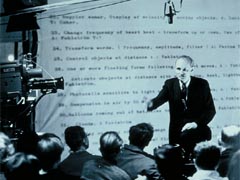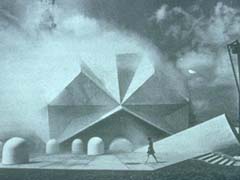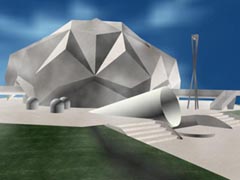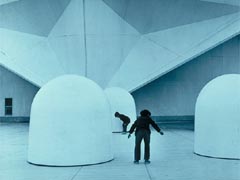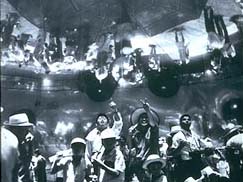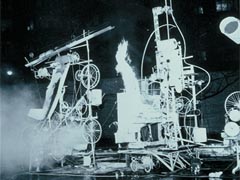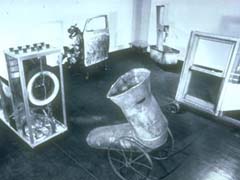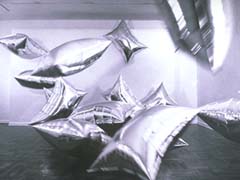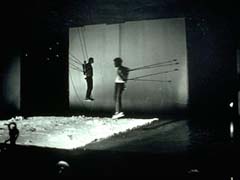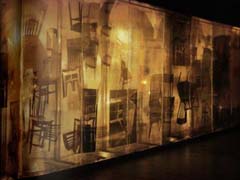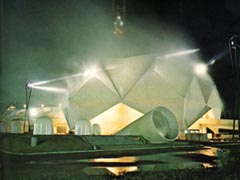"The new interface I will define is one in which the artist makes active use of the inventiveness and skills of an engineer to achieve his purpose. The artist could not complete his intentions without the help of an engineer. The artist incorporates the work of the engineer in the painting or the sculpture or the performance." – Billy Klüver
IntroductionIn the late 1950s, the Swedish-born engineer Billy Klüver worked on laser systems for Bell Laboratories in Murray Hill, New Jersey. Klüver, however, was not satisfied by purely scientific pursuits, and his interests led him to explore the artistic milieu that gave rise to pop art, minimalism, and Happenings a short drive away in New York City. Klüver befriended the leading exponents of the new arts, which led to collaborations in the 1960s with such key figures as Jean Tinguely, Robert Rauschenberg, Jasper Johns, Andy Warhol, and John Cage. During this period, Klüver more than anyone, foresaw the potential for the integration of art and technology. Inspired by Aristotle's notion of Techne – in which there was no differentiation between the practice of art and science – Klüver proposed the active and equal participation of the artist and engineer in the creation of the artwork. In this collaboration, he believed that the engineer required the participation of the artist, who as a "visionary about life" and an active agent of social change, involved the engineer in meaningful cultural dialog. At the same time, he felt that the artist, in the spirit of Rauschenberg's famous credo to 'close the gap between art and life,' had an obligation to incorporate technology as an element in the artwork, since technology had become inseparable from our contemporary lives. In 1966, Klüver founded the now legendary E.A.T. (Experiments in Art and Technology) with Robert Rauschenberg, Fred Waldhauer, and Robert Whitman. E.A.T. encouraged the collaboration of artists and engineers across the country in interdisciplinary technology-based art projects. Klüver's work takes on increasing significance as the notion of the synthesis of art and technology, artist and engineer, has been assimilated into the contemporary arts. Despite the historical significance of Billy Klüver's contribution to the evolution and subsequent widespread adoption of technology in contemporary art, the work he produced and its influence on recent media work is not well known nor has it received a great deal of informed critical discussion. Billy Klüver's contribution to the history of electronic media art extends far beyond the notion of new techniques, new materials, and new genres. His efforts to bridge the divide between the arts and sciences was driven by a desire to nurture the collaborative spirit. In doing so, he sought to bring the artist closer to the materials of technology and thus more in touch with the forces shaping contemporary society, inspired by the revolutionary cultural, aesthetic, and technological transformations of the 1960s. He also strove to introduce the artists' world to the scientist, whom he believed would, as a result, become more engaged with issues critical to society and culture. These seminal ideas have since become fundamental to the open forms and participatory nature of contemporary electronic and digital art. Exhibition Overview"Art & Engineering: The Birth of a New Medium" celebrates this achievement by introducing a relatively unknown body of work in order to provide historical and critical context that illuminates contemporary concerns, techniques, and strategies adopted by present day digital media artists, theorists, and critics. The exhibition is divided into two parts:
The exhibition will include extensive collateral documentation containing critical, historical and technical texts, as well as a Website with numerous reproductions of artworks, technical diagrams, and archival materials. The Pavilion"The initial concern of the artists who designed the Pavilion was that the quality of the experience of the visitor should involve choice, responsibility, freedom, and participation. The Pavilion would not tell a story or guide the visitor through a didactic, authoritarian experience. The visitor would be encouraged as an individual to explore the environment and compose his own experience." – Billy Klüver
The most ambitious work produced by Billy Klüver and E.A.T. was the Pepsi Pavilion, a multimedia theatrical space and interactive environment created for the Expo '70 in Osaka, Japan. Though the Pavilion is often noted in historical accounts of media art, only those who visited the exposition were able to experience firsthand what has come to be known as one of the most ambitious and groundbreaking collaborative art and technology projects of the 20th Century. The Pepsi Pavilion was one of the first immersive artworks to engage viewers through electronic media. The work predates recent developments in virtual reality, interactive installations, and other VR experiences that transport the viewer to electronically-mediated worlds. The Pepsi Pavilion also served as a forerunner to the changing, participatory relationship between viewer, artist, and artwork in contemporary media art. The reconstructed Pavilion unites physical and virtual space by extending the original environment – an elaborate and complex space that included a spherical mirror and multi-channel sound system –with a 3D rendering that distributes the Pavilion via a network of virtual installations and a Web-based multi-user environment.
The Pavilion facilitates distributed multi-user interaction in a fully 3-dimensional virtual reality world by networking the physical structure with museum-based installations as well as an interactive environment constructed specifically for the Web. Viewers (both on-site and on-line) will collectively experience the responsive elements of the Pavilion including: the 210 degree spherical mirror that reflects 3-dimensional "real images" similar to holograms; a programmable, multi-channel surround-sound system performed live from a control console on the floor of the Pavilion to sculpt real-time musical compositions; kinetic sculptures (Floats) that playfully roam the exterior of the physical structure; and a fog sculpture that enshrouds the exterior in a fine mist, responding to the changing weather patterns. The Pavilion has been conceived, like the original, as a stage for the creation of new environments and performance installations by contemporary artists . A selection of artists, composers, and performers will be invited to create original works that challenge the notion of the responsive environment in ways that were unimaginable in 1970 and are only possible today through the implementation of new digital technologies. Nevertheless, this transformation draws from the fundamental notion of audience participation and interaction that was integral to the original work. The Pavilion invites the audience, in Klüver's words, "to compose its own experience," thus encouraging a more participatory, collaborative relationship between artist, viewer and artwork.
Artists, Engineers, and Collaboration"Experiments in art and technology is established to develop an effective collaboration between engineer and artist. The raison d'être of E.A.T. is the possibility of a work which is not the preconception of either the engineer or the artist, but which is the result of the exploration of the human interaction between them." – Billy Klüver
"Artists, Engineers and Collaboration" surveys the work of Billy Klüver and E.A.T. during the 10 year period from 1960 to 1970. This component of the exhibition includes selected artworks from Klüver's numerous collaborations with artists including Jean Tinguely, Andy Warhol, Robert Rauschenberg, John Cage, Merce Cunningham, Jasper Johns, among others. It also includes works from other artist-engineer collaborations during E.A.T.'s tenure between 1966 and 1970, most notably from the exhibition "Some More Beginnings" held at the Brooklyn Museum in 1968. Additionally, the exhibition will include selections from the E.A.T. archives including films, photographs, posters, newsletters, and other key memorabilia. The exhibition will be documented by a comprehensive book of critical writings by and about Klüver, as well as an accompanying Website which serves to provide historical context, offering a chronological account of Klüver and E.A.T. collaborations and its broad influence on thousands of artists who participated in E.A.T. exhibitions and events around the country. This historical chronology is based on writings by Billy Klüver, a fascinating and detailed account of collaborations that includes an extensive collection of photographs of artworks and their creators, film and audio clips from performances and exhibitions, and hundreds of interviews, technical diagrams, and artist sketches. "Artists, Engineers and Collaboration" begins dramatically in 1960 with the "Homage to New York," Klüver's first collaboration with the Swiss artist Jean Tinguely, in which their kinetic machine sculpture destroyed itself in the Sculpture Garden of the Museum of Modern Art in New York.
"Artists, Engineers, and Collaboration" surveys the ensuing decade of interactive electronic works: Andy Warhol's experimentation with floating sculpture; the "9 Evenings of Theater and Engineering" performances of 1966 held at the 69th Regiment Armory in New York that brought together Rauschenberg, John Cage, and over 30 other artists and engineers; the formation of E.A.T (Experiments in Art and Technology) in 1966; the 1968 "Some More Beginnings" show at the Brooklyn Museum in association with the Museum of Modern Art's groundbreaking "The Machine As Seen at the End of the Mechanical Age," the first major exhibition of electronic art in the United States; interactive installations with Robert Rauschenberg including Oracle (1965) and Solstice (1968), and finally, the Pepsi Pavilion (1970), E.A.T.'s penultimate project.
"The artist is a visionary about life. Only he can create disorder and still get away with it. Only he can use technology to its fullest capacity. The artists have to use technology because technology is becoming inseparable from lives." – Billy Klüver |

